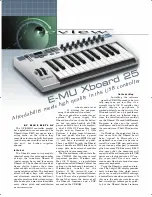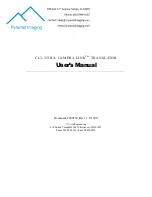
RECORDING JANUARY 2006
58
The USB MIDI controller market
has exploded in recent months. The
Xboards from E-MU occupy an inter-
esting niche: on the surface they
seem like ordinary no-frills keyboards
(and their prices would seem to bear
this out),
but hidden surprises
abound.
In the box
The Xboards come in two models,
identical except for price and number
of keys: the two-octave Xboard 25
(under review here) and four-octave
Xboard 49. The keyboard is made of
dense plastic, heavier than some
other models out there, with a reas-
suring solidity and heft. The keyboard
offers full-sized keys with velocity
and aftertouch sensitivity, and front-
panel controls include sixteen assign-
able knobs plus a master volume/data
entry slider, pitch and modulation
wheels, and a set of
12 buttons for program-
ming the keyboard’s functions.
The rear panel has a socket for an
optional DC power supply. The
Xboard can also use three AA batter-
ies but ran quite handily off USB
power on both of our test computers,
a dual 2 GHz G5 Power Mac from
Apple and an Ozma-m 3.4 GHz
Pentium 4 laptop from Alienware.
The rear panel also has a power
switch, USB connector, MIDI Out, and
1
/
4
" jack for a footswitch or pedal.
There’s no MIDI In jack; the Xboard
doesn’t double as a MIDI interface to
accept data from external modules
and send it to your computer.
The Xboard comes with an installa-
tion CD-ROM that features several
important products: Windows and
Mac OS X drivers, a crossplatform
application called Xboard Control for
setting up the keyboard’s functions, a
Windows-only installer for the
Proteus X LE softsynth, and a
Windows-only ‘lite’ version of Ableton
Live 4. There’s also a printed Owner’s
Manual that covers the basics of all
the Xboard’s functions, and a PDF
manual on the CD-ROM.
On the desktop
Installing the software
from the CD-ROM proved to be triv-
ially simple on our test Mac: it’s a
straight Apple OS X installer that
doesn’t require a passphrase. It
worked perfectly on the first try. Our
Windows install was a bit problemat-
ic—even when we followed direc-
tions, the installed software couldn’t
see the Xboard. We used Add/Remove
Programs to clear out the install,
tried again, and had it work perfectly
the second time. (That’s Windows for
you.)
On Windows, the quick-start litera-
ture warns that the Xboard hasn’t
been “signed” by Microsoft as a
peripheral, so you need to be sure to
install it on one USB port and not try
to use it on any other port (a common
glitch for many USB devices). E-MU
also warns that the computer will
expect the Xboard to require full USB
power even if plugged into a DC sup-
ply, so you can’t use it on a conve-
nience port like those found on some
computer keyboards.
Using the Xboard is quick and intu-
itive. The 3-digit LED display provides
basic information, like which preset
you’re set to and what MIDI message
a controller sends when you move it. If
this were the only user interface you
had, it would get tedious pretty quick-
ly, but the Xboard Control software
Affordability meets high quality in this USB controller
B Y M I K E
M E T L A Y
REC mag 01-06 Final 11/23/05 8:15 AM Page 58




















